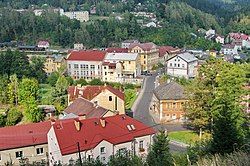Oloví
Oloví | |
|---|---|
 View from a hill | |
| Coordinates: 50°14′44″N 12°33′3″E / 50.24556°N 12.55083°E | |
| Country | |
| Region | Karlovy Vary |
| District | Sokolov |
| Founded | 1523 |
| Government | |
| • Mayor | Jiří Mikuláš |
| Area | |
• Total | 19.05 km2 (7.36 sq mi) |
| Elevation | 528 m (1,732 ft) |
| Population (2024-01-01)[1] | |
• Total | 1,641 |
| • Density | 86/km2 (220/sq mi) |
| Time zone | UTC+1 (CET) |
| • Summer (DST) | UTC+2 (CEST) |
| Postal code | 357 07 |
| Website | www |
Oloví (German: Bleistadt) is a town in Sokolov District in the Karlovy Vary Region of the Czech Republic. It has about 1,600 inhabitants.
Administrative parts
[edit]The villages of Hory, Nové Domy and Studenec are administrative parts of Oloví.
Etymology
[edit]Both the Czech name Oloví and German name Bleistadt refer to the reason for the founding of the town, which was lead mining (lead = olovo in Czech and Blei in German).
Geography
[edit]Oloví is located about 10 kilometres (6 mi) northwest of Sokolov and 21 km (13 mi) west of Karlovy Vary. It lies in the western part of the Ore Mountains. The highest point is at 681 m (2,234 ft) above sea level. The Svatava River flows through the town.
History
[edit]Oloví was founded by Stephan Schlick in 1523 within his newly acquired Hartenberg estate. Since its foundation, lead and to a lesser extent silver were mined in the area. After the properties of the Schlick family were confiscated by King Ferdinand I, the estate was acquired by Lords of Plauen in 1551. In 1561, Ferdinand I separated Oloví from the Hartenberg estate and promoted it to a royal mining town. Because of the Thirty Years' War, the collapsing of tunnels and floods on the Svatava River, mining was reduced.[2]
From 1938 to 1945, the town was annexed by Nazi Germany and administered as part of the Reichsgau Sudetenland. After World War II, the German population was expelled.
Demographics
[edit]
|
|
| ||||||||||||||||||||||||||||||||||||||||||||||||||||||
| Source: Censuses[3][4] | ||||||||||||||||||||||||||||||||||||||||||||||||||||||||
Transport
[edit]Oloví is located on the railway line Sokolov–Kraslice.
Sights
[edit]
The main landmark of Oloví is the Church of Saint Michael the Archangel. It was built in the neo-Gothic style in 1901–1902.[5]
Twin towns – sister cities
[edit] Kastl, Germany
Kastl, Germany
References
[edit]- ^ "Population of Municipalities – 1 January 2024". Czech Statistical Office. 2024-05-17.
- ^ "Historie Oloví" (in Czech). Město Oloví. Retrieved 2023-12-11.
- ^ "Historický lexikon obcí České republiky 1869–2011" (in Czech). Czech Statistical Office. 2015-12-21.
- ^ "Population Census 2021: Population by sex". Public Database. Czech Statistical Office. 2021-03-27.
- ^ "Kostel sv. Michaela archanděla" (in Czech). National Heritage Institute. Retrieved 2023-12-11.
- ^ "Partnerské město Kastl" (in Czech). Město Oloví. Retrieved 2023-12-11.
External links
[edit]


